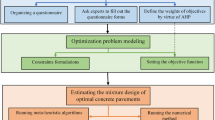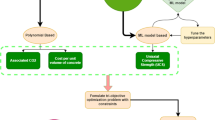Abstract
Aggregate blending is a complex process especially when more sizes of aggregates need to be blended. For rough usage or to offer an initial answer, the conventional approaches are adequate. However, to obtain a cost-effective blend that meets specification requirements, more aggregate sizes must be accommodated. Several methods were investigated by various authors to deal with this complex process. Most of the methods are confined to a blending of three or four sizes of aggregates only. In this study, an attempt has been made to assess various computational techniques for aggregate blending to optimize the aggregate gradation area. Aggregates grading requirements specified for Dense Bituminous Macadam Grade-2 in MORT&H 500-10 was chosen as a reference. For this grading specifications, various methods like trial-and-error, mid-point gradation, least-square optimization, Generalised Reduced Gradient (GRG) non-linear, GRG multi start, simplex linear programming, regression analysis, IRC SP:89-2010, quadratic programming, support vector machines-SMoreg, path variate analysis, interval method, R programming were employed, and optimal proportions for aggregate blending were obtained. Curve fitting along with integration was applied to determine the aggregate gradation area under the combined gradation curve and maximum density line. The existence of a gradation curve between upper and lower limits and close to the mid-point line is considered as the first check and the minimum aggregate gradation area is considered as a second check while evaluating different optimal proportions arrived. Least aggregate gradation area which implies the minimum percentage of air voids was obtained for simplex LP (UL and LL) and evolutionary algorithm (Genetic algorithm) methods, i.e., 6.885. But these two methods yielded a filler of zero percentage which is practically not possible, hence simplex LP (MID) satisfies all the criterion and is adopted as the best method for aggregate blending.




Similar content being viewed by others
Data availability
The datasets generated during or analysed during the current study are available from the corresponding author on reasonable request.
References
Hs, M. A. (2018). Bituminous mix design studies using high density polyethylene on BC layer. International Journal of Engineering Research & Technology, 7(06), 248–257.
Mishra, B. (2016). Use of plastic waste in bituminous mixes of flexible pavements by wet and dry methods: A comparative study. International Journal of Modern Engineering Research, 6(3), 41–50.
Sangita, K. T. A., & Sabina, S. D. K. (2011). Effect of waste polymer modifier on the properties of bituminous concrete mixes. Construction and Building Materials, 25(10), 3841–3848. https://doi.org/10.1016/j.conbuildmat.2011.04.003
Mathew, T. V, & Rao, K. (2007). Dry mix design. In: Introduction to transportation engineering, 25.1–25.4. http://nptel.ac.in/courses/105101087/downloads/Lec-25.pdf
Ashebir Alyew Mamo. (2019). Determining the physical properties of aggregate products and its suitability for road base construction, Ethiopia. International Journal of Engineering and technical Research, V8(12), 210–216.
Rubio, M. C., Moreno, F., Belmonte, A., & Menéndez, A. (2010). Reuse of waste material from decorative quartz solid surfacing in the manufacture of hot bituminous mixes. Construction and Building Materials, 24(4), 610–618. https://doi.org/10.1016/j.conbuildmat.2009.09.004
Singh, P., & Walia, G. S. (2014). Review of optimization methods for aggregate blending. International Journal of Advanced Research in Civil, Structural, Environmental and Infrastructure Engineering and Developing, 1(3), 1–9.
Asphalt Institute. (2015). Asphalt mix design methods (Metodos de Diseño de Concreto Asfaltico).
Cheng, Y. H., Zhu, B. L., Yang, S. H., & Tong, B. Q. (2021). Design of concrete mix proportion based on particle packing voidage and test research on compressive strength and elastic modulus of concrete. Materials, 14(3), 1–17. https://doi.org/10.3390/ma14030623
Lee, D. Y. (1973). Review of aggregate blending techniques. Highway Research Record, 441, 111–127.
Bangdiwala, S. I. (2018). Regression: Simple linear. International Journal of Injury Control and Safety Promotion, 25(1), 113–115. https://doi.org/10.1080/17457300.2018.1426702
Ramu, P., Sarika, P., Kumar, V. P., & Sravana, P. (2016). Analytical method for asphalt concrete job mix formula Design. International Research Journal of Engineering and Technology, 03(10), 7.
Soujanya, C., Priya, G. A., Ramu, P., & Kumar, C. N. (2019). A novel technique to design optimum bituminous mix designs based on R studio and autograph with integration. Materials Today: Proceedings, 18, 4566–4579. https://doi.org/10.1016/j.matpr.2019.07.431
Mirmohseni, S. M., & Nasseri, S. H. (2017). A quadratic programming with triangular fuzzy numbers. Journal of Applied Mathematics and Physics, 05(11), 2218–2227. https://doi.org/10.4236/jamp.2017.511181
Ebeed, M., Kamel, S., & Jurado, F. (2018). Optimal power flow using recent optimization techniques. Elsevier Inc. https://doi.org/10.1016/B978-0-12-812441-3.00007-0
Arora, J. S. (1990). Computational design optimization: A review and future directions. Structural Safety, 7(2–4), 131–148. https://doi.org/10.1016/0167-4730(90)90063-U
Maia, A., Ferreira, E., Oliveira, M. C., Menezes, L. F., & Andrade-Campos, A. (2017). Numerical optimization strategies for springback compensation in sheet metal forming. In: Computational methods and production engineering: Research and development. Elsevier Ltd. https://doi.org/10.1016/B978-0-85709-481-0.00003-3
Sharma, R., & Glemmestad, B. (2013). On generalized reduced gradient method with multi-start and self-optimizing control structure for gas lift allocation optimization. Journal of Process Control, 23(8), 1129–1140. https://doi.org/10.1016/j.jprocont.2013.07.001
Transactions, T., & Techniczne, C. (2016). Application of the mathematical programming in solving the managerial problems encountered in the production, trade of construction materials and purchases organization. ZASTOSOWANIE METOD PROGRAMOWANIA MATEMATYCZNEGO DO ROZWIĄZYWANIA PROBLEMÓW MENEDŻERSK. https://doi.org/10.4467/2353737XCT.16.155.5766
Streiner, D. L. (2005). Finding our way: An introduction to path analysis. Canadian Journal of Psychiatry, 50(2), 115–122. https://doi.org/10.1177/070674370505000207
Bai, Y. (1991). Part VI Integrity Management Chapter 41 LCC Modeling as a Decision Making Tool in Pipeline Design. 1999, 1999.
Gove, R., & Faytong, J. (2011). Identifying infeasible GUI test cases using support vector machines and induced grammars. In: Proceedings—4th IEEE international conference on software testing, verification, and validation workshops, ICSTW 2011, 202–211. https://doi.org/10.1109/ICSTW.2011.73
Widemann, B. T. Y., Bolz, C. F., & Grelck, C. (2013). The functional programming language R and the paradigm of dynamic scientific programming (Position paper). Lecture notes in computer science (including subseries lecture notes in artificial intelligence and lecture notes in bioinformatics), (vol. 7829 LNCS(January 2016), pp. 182–197). https://doi.org/10.1007/978-3-642-40447-4_12
Attaway, S. (2017). Advanced mathematics. In: Matlab. https://doi.org/10.1016/b978-0-12-804525-1.00014-3
Ritter, J. B., & Shaffer, L. R. (1961). Blending Natural Earth Deposits for Least Cost. Journal of the Construction Division, 87(1), 39–61. https://doi.org/10.1061/JCCEAZ.0000036.
Neumann, D. L. (1964). Mathematical Method for Blending Aggregates. Journal of the Construction Division, 90(2), 1–13. https://doi.org/10.1061/JCCEAZ.0000109.
Easa, S. M., & Can, E. K. (1985). Optimization Model for Aggregate Blending. Journal of Construction Engineering and Management, 111(3), 216–230.
Parton, G. M., Shariatmadari, A. A., & Hansom, R. G. (1989). Efficiency in aggregate mix design: a ‘least squares’ method. International Journal of Cement Composites and Lightweight Concrete, 11(3), 167–174. https://doi.org/10.1016/0262-5075(89)90089-4.
Toklu, Y. C. (2005). Aggregate Blending Using Genetic Algorithms. Computer-Aided Civil and Infrastructure Engineering, 20(6), 450–460. https://doi.org/10.1111/j.1467-8667.2005.00394.x.
Sivilevičius, H., Podvezko, V., & Vakrinienė, S. (2011). The use of constrained and unconstrained optimization models in gradation design of hot mix asphalt mixture. Construction and Building Materials, 25(1), 115–122. https://doi.org/10.1016/j.conbuildmat.2010.06.050.
Awuah-Offei, K., & Askari-Nasab, H. (2011). Aggregate Cost Minimization in Hot-Mix Asphalt Design. Journal of Materials in Civil Engineering, 23(5), 554–561. https://doi.org/10.1061/(ASCE)MT.1943-5533.0000211.
Kikuchi, S., Kronprasert, N., & Easa, S. M. (2012). Aggregate Blending Using Fuzzy Optimization. Journal of Construction Engineering and Management, 138(12), 1411–1420. https://doi.org/10.1061/(ASCE)CO.1943-7862.0000557.
Swamy, A. K., Sandhu, K. K., & Foxlow, J. (2018). Improving quality control through chance constrained programming: A case study using Bailey method. International Journal of Pavement Research and Technology, 11(2), 128–137. https://doi.org/10.1016/j.ijprt.2017.11.004.
Ramayya, V. V., Ram, V. V., & Krishnaiah, S. (2019). Job mix formulation for bituminous concrete grade II using C # programming (Vol. 12, pp. 26–34).
Funding
The authors declare that no funds, grants, or other support were received during the preparation of this manuscript.
Author information
Authors and Affiliations
Corresponding author
Ethics declarations
Ethical Approval
Not applicable.
Conflict of Interest
The authors whose names are listed immediately below certify that they have no affiliations with or involvement in any organization or entity with any financial interest (such as honoraria; educational grants; participation in speakers’ bureaus; membership, employment, consultancies, stock ownership, or other equity interest; and expert testimony or patent-licensing arrangements), or non-financial interest (such as personal or professional relationships, affiliations, knowledge or beliefs) in the subject matter or materials discussed in this manuscript. The authors have no relevant financial or non-financial interests to disclose.
Rights and permissions
Springer Nature or its licensor (e.g. a society or other partner) holds exclusive rights to this article under a publishing agreement with the author(s) or other rightsholder(s); author self-archiving of the accepted manuscript version of this article is solely governed by the terms of such publishing agreement and applicable law.
About this article
Cite this article
Penki, R., Rout, S.K. & Das, A.K. Computational Techniques for Proportioning of Aggregates in Bituminous Mix Design. Int. J. Pavement Res. Technol. 17, 694–706 (2024). https://doi.org/10.1007/s42947-022-00264-w
Received:
Revised:
Accepted:
Published:
Issue Date:
DOI: https://doi.org/10.1007/s42947-022-00264-w




